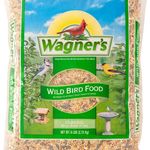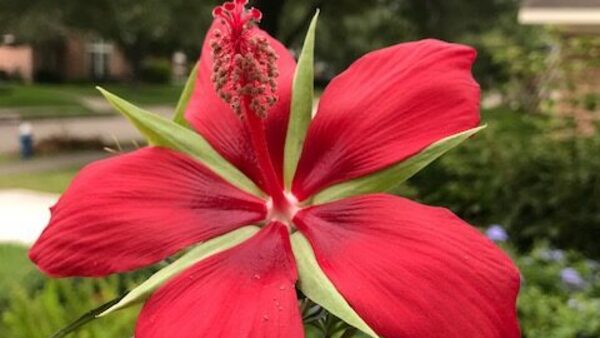
Hi GPODers!
Today we’re venturing to a part of the US we don’t get to see very often on the blog (If you’re from this area and lurking on GPOD, please send in some photos of your gardens!). We’re heading to Weslaco, Texas to see the pollinator and wildlife haven that is Lisa Kay Adam’s garden.
For the last four years, I’ve lived in a cottage in a 55+ community near the very southern border of Texas (zone 10a). I have a small patio of container plants and three garden beds around my 850 sq. ft. house. I use my training as a Texas Master Naturalist to help me select plants that look good, survive our brutal summers, and serve wildlife. Even in my limited space, I’ve identified over three dozen species of animals directly using my plants for food or shelter.
This long bed filled with just a few species is where most of the action is. Despite its small blooms, the row of tall turk’s cap (Malvaviscus arboreus var. drummondii, Zones 7–11) is a hummingbird buffet, both for migrating ruby-throated hummers and our year-round buff-bellied species. Turk’s cap also provides fruit for mockingbirds and kiskadees, and serves as a butterfly host plant. Mounding orange zexmenia (Wedelia acapulcensis var. hispida, Zones 8–11) serve as host and nectar plants, and lesser goldfinch gobble their seeds. In the corner, American beautyberry (Callicarpa americana, Zones 6–10) and (not visible) a native Chile pequin (Capsicum annuum, Zones 9–11) give additional fruit for birds. Interspersed red yucca (Hesperaloe parvilfora, Zones 6–11) provide nectar during blooming.
 A fountain and bird feeder, as well as the live oak (Quercus virginiana, Zones 8–10) in a shared courtyard, draw additional species. (I don’t recommend the granite mulch, by the way—in this area it raises the temperature too much and doesn’t add nutrients to the soil—but it is required by my community.)
A fountain and bird feeder, as well as the live oak (Quercus virginiana, Zones 8–10) in a shared courtyard, draw additional species. (I don’t recommend the granite mulch, by the way—in this area it raises the temperature too much and doesn’t add nutrients to the soil—but it is required by my community.)
 It wouldn’t be Texas without a Texas “sage” or cenizo (Leucophyllum frutescens, Zones 8–10), which is also a host plant for the Theona checkerspot. Also featured in this photo are a young Rio Grande barrel cactus (Ferocactus hamatacanthus var. sinuata, Zones 7–10), pale leaf yucca (Yucca pallida, Zones 6–10) frogfruit (Phyda nodiflora, Zones 7–11), and a cultivar of Lantana camara. I added the frogfruit ground cover as a host plant for the white peacock butterflies I frequently saw nectaring at the lantana.
It wouldn’t be Texas without a Texas “sage” or cenizo (Leucophyllum frutescens, Zones 8–10), which is also a host plant for the Theona checkerspot. Also featured in this photo are a young Rio Grande barrel cactus (Ferocactus hamatacanthus var. sinuata, Zones 7–10), pale leaf yucca (Yucca pallida, Zones 6–10) frogfruit (Phyda nodiflora, Zones 7–11), and a cultivar of Lantana camara. I added the frogfruit ground cover as a host plant for the white peacock butterflies I frequently saw nectaring at the lantana.
 Many of our native species have small leaves and flowers as an adaptation to reduce moisture loss. This heartleaf hibiscus (Hibiscus martianus, Zones 8–10) still puts on a show in part shade with its 2 inch blooms.
Many of our native species have small leaves and flowers as an adaptation to reduce moisture loss. This heartleaf hibiscus (Hibiscus martianus, Zones 8–10) still puts on a show in part shade with its 2 inch blooms.





Thank you so much for sharing your beautiful and beneficial garden, Lisa! For northern gardeners like myself, seeing your plantings is a delightful foray into plants we’re only able to grow as annuals or are not familiar with at all.
I think I speak for all of GPOD in saying, we’d love to see more diverse gardens from all climates and landscapes. Also a reminder that we love to see indoor gardens, public gardens, wreaths/arrangements and even art made from plants. If you haven’t seen your “type” of garden or gardening on the blog before, don’t be afraid to be the first! Follow the directions below to submit photos, or send me a DM on Instagram: @agirlherdogandtheroad
Have a garden you’d like to share?
Have photos to share? We’d love to see your garden, a particular collection of plants you love, or a wonderful garden you had the chance to visit!
To submit, send 5-10 photos to gpod@taunton.com along with some information about the plants in the pictures and where you took the photos. We’d love to hear where you are located, how long you’ve been gardening, successes you are proud of, failures you learned from, hopes for the future, favorite plants, or funny stories from your garden.
Have a mobile phone? Tag your photos on Facebook, Instagram or Twitter with #FineGardening!
Do you receive the GPOD by email yet? Sign up here.
Fine Gardening Recommended Products

The Nature of Oaks: The Rich Ecology of Our Most Essential Native Trees
Fine Gardening receives a commission for items purchased through links on this site, including Amazon Associates and other affiliate advertising programs.

Wagner's 52003 Classic Blend Wild Bird Food, 6-Pound Bag
Fine Gardening receives a commission for items purchased through links on this site, including Amazon Associates and other affiliate advertising programs.

Planting in a Post-Wild World: Designing Plant Communities for Resilient Landscapes
Fine Gardening receives a commission for items purchased through links on this site, including Amazon Associates and other affiliate advertising programs.


















Comments
This is a wonderful small garden - looks exactly as it should. I sure do wish that community "bosses" would invest a little time to see what's best instead of just deciding that one thing works because it "looks good." Do they really think that using something that raises ground temperatures in a place as hot as Texas is a good idea? Sigh... Anyway, you have truly created an oasis and I salute you!
Lisa - a lot of care and planning has gone into your garden and it shows. I especially liked the photo of the queen butterfly on the mist flower. Thank you for sharing!
Log in or create an account to post a comment.
Sign up Log in